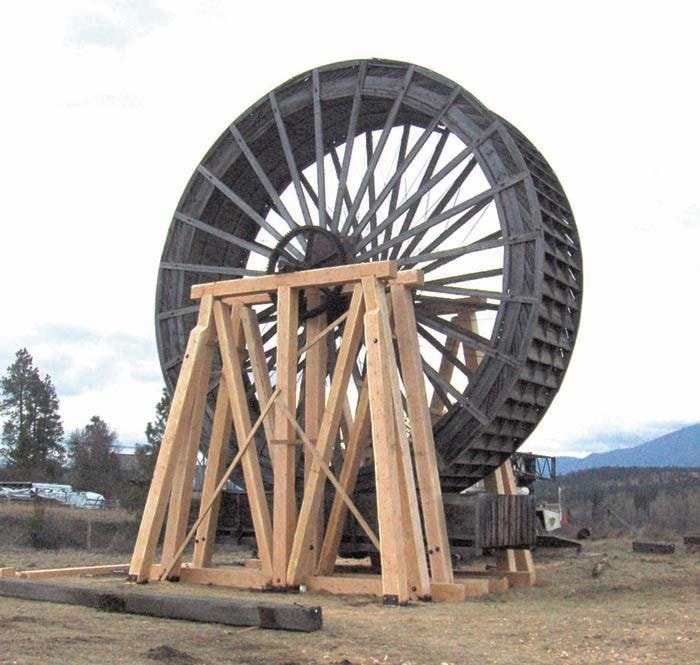As you drive past Fort Steele Heritage Town, it’s hard not to marvel at the more than a century old engineering feat that is the water wheel. It stands above the Kootenay River and tells of a bygone era of gold fever and the Wild West.
Thanks to a newly built support, which was installed last week, it will be around for years to come.
The retrofit of the waterwheel has been in the works for a number of years.
Brad Froggatt, manager of Heritage Services at Fort Steele, said the retrofit was badly needed.
“We noticed that — since the original structure supporting the wheel was put in in 1965 and it had never been replaced — we had to do an inspection on it,” Froggatt said. “We realized that it was weak and we also noticed that the wheel itself had been listing to one side and rubbing against the frame.”
Froggatt said that since the support wasn’t original to the structure, they decided to replace the structure and preserve the wheel, which is the original.
The whole wheel was moved to the current site in 1965 — that’s also when the bottom structure was built to hold the wheel.
The wheel itself was built in 1899 and decommissioned around 1934. It was originally used in gold mining up Perry Creek. It was an overshot mine and at the time the wheel was used to supply power to two pumps that were used in mining in the Kootenay River.
“You’ll notice if you come out here and look under the wheel itself and if you go down on the ground, you’ll see there are a couple more other pieces of equipment around it,” he said. “Those are the rest of the gears and rest of the structures that would’ve been used to power the pumps.”
He said the wheel is the only remaining water wheel of its type that still exists in the area.
“When they found it, it had been sitting in Perry Creek for a long time, so they decided to rescue it,” he said. “It does fall within our interpretive scope in that the whole area was known for gold mining.”
The repairs used new wood, so they will be evident for the next few years — until the wood has been weathered.
“It will look the same in the long term,” Froggatt said. “We had lots of debates about this wheel, because after all it’s not from Fort Steele. However, being that it’s perched there above the Kootenay River, visible as you come down the mountain on Highway 3/95, it’s become an iconic symbol for Fort Steele.”
Froggatt said he hopes that they can get some lighting on the wheel so it will be visible at nighttime from the highway.
“When you look at it closely, it’s quite an engineering marvel. It’s this huge wooden wheel, with all these scoops on the outside for moving water,” he said. “It’s also braced with long metal rods and supports. It’s really amazing that it’s lasted as long as it has. We don’t find many wooden structures that big anymore.”
Froggatt said the process of building the support structure took quite a while.
“It took a few months, because the wood had to be milled locally, and it’s hard to find trees that big,” he said. “Everything was measured and pre-cut and brought onsite.”
It was all laid out so that it could be assembled immediately once the work started.
They worked with local timber framer Dan Higgs and his partner, as well as students from the College of the Rockies timber framing course.
On Wednesday, the crews were at the site with two cranes. They lifted the wheel and suspended it while they tore down the old structure and put up the new one.
“Luckily the concrete bases and the middle brackets that hold it together were all still stable and they were in good condition,” Froggatt said. They started at 8 a.m. and late Wednesday night it was assembled together with only minor tweaks left to complete.
The same crew is working on a new support for the water tower.
The funding came through the Province of B.C. heritage branch.
“Even though the society runs the park, it is done through a partnership with he province,” he said. “The province technically owns the site.”
The project cost around $75,000.
